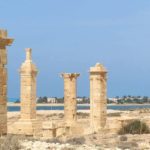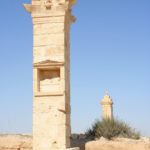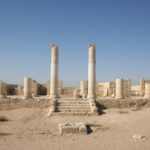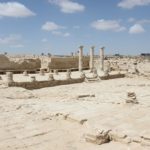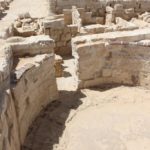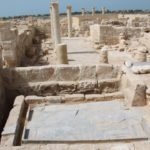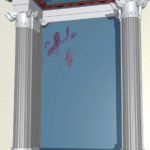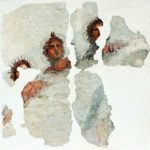Polish–Egyptian Conservation Mission Marina el-Alamein
Most interesting finds:
– necropolis from the Hellenistic and Roman period
– residential houses from the Roman period
– main city square (forum) and public buildings surrounding it
– Hellenistic public baths
– Roman public baths
– aediculae with exceptional architectural decoration; one with a fragment of figurative painting with depictions of Helios, Harpocrates and Serapis
– unique geometric architectural decoration (“Marina type” capitals)
History of research:
Dates of PCMA mission’s work:
1995–2018
Type of research:
Archaeological, architectural, conservation work
Directors:
Stanisław Medeksza (1995–2011)
Rafał Czerner, Faculty of Architecture, Wrocław University of Science and Technology (2012–2018)
Co-operating institutions:
– Polish Centre of Mediterranean Archaeology, University of Warsaw
– Faculty of Architecture, Wrocław University of Science and Technology
– Ministry of State for Antiquities
and
– The Inter-Academy Institute of Conservation and Restoration of Works of Art
– Centre for Comparative Studies of Civilisations, Jagiellonian University
Additional information:
Relics of Hellenistic and Roman buildings were discovered unexpectedly in 1985 during the construction of a modern tourist village in the coastal area and investigated scientifically by Prof. Wiktor A. Daszewski. In 1986, Egyptian archaeologists from the Department of Antiquities conducted salvage excavations to protect the architectural remains from destruction during construction works. The archaeological exploration of the site, carried out by the Polish Archaeological Mission of the Polish Centre of Mediterranean Archaeology, University of Warsaw under the direction of Wiktor A. Daszewski, lasted until 2006. Since 1988, subsequent Polish-Egyptian conservation missions have worked in the area of the ancient city, directed by architects Włodzimierz Bentkowski (1988–1989) and Jarosław Dobrowolski (1990–1993). The present Conservation Mission started in 1995, was headed by Prof. Stanisław Medeksza until 2011, and is now directed by Prof. Rafał Czerner from the Faculty of Architecture, Wrocław University of Science and Technology.
Description of the site and research:
The excavations encompass a coastal area more than 1 km long and about 550 m wide. Thanks to the architectural and archaeological research, it is possible to reconstruct the layout of the ancient city discovered here. Port infrastructure filled the quay of the lagoon, as evidenced by preserved relics of storerooms. To the south lay the city center with the main square surrounded by porticoes (Figs 4, 5), two baths buildings: Hellenistic (Fig. 6) and Roman (Fig. 7), as well as a neighboring basilica. This part of the city was encircled by dense residential quarters (Fig. 8). From the west and south, a vacant strip of land separated the city from a vast necropolis. Relics of an Early Christian basilica were discovered in the non-built-up area in the east.
Although the ancient city did not have a regular layout, the streets ran more or less parallel from east to west. The houses were generally oriented to match such a grid.
About 50 buildings were discovered in the city and the necropolis, the oldest of them in the cemetery. Pillar funerary monuments of unique form, a characteristic feature of Marina (Figs 1, 2), were erected from the end of the 1st century BC. Numerous hypogea with underground courtyards, built during the whole period of the town’s functioning, are sometimes quite extensive and have monumental above-ground mausolea with frontal porticoes (Fig. 3). Most of the residential houses date to the Roman period; however, a few earlier remains are sometimes found there as well. The houses were transformed and extended with time. The largest had courtyards with one, mostly two porticoes (in one case, three). The layout of the courtyards and main chambers is usually almost axial, although pastas and prostas arrangements of Greek origin also occur. The known architectural relics in the central part of the city date to the 1st–2nd century. The main square, an agora or forum, was surrounded on three sides by porticoes, which had been built in stages. On the fourth, west side, it opened on to a wide street, one of the major ones in the city. On the opposite side, the square was adjoined by a peristyle, which preceded a representative building, perhaps a temple. To the north stood Hellenistic public baths of the tholos type (Fig. 6); to the south, later Roman baths with a serial arrangement of the main bathing rooms (Fig. 7).
From the beginning, the Polish–Egyptian Conservation Mission has carried out a wide range of research on the residential houses. Besides conservation works, the team also conducts research on the necropolis. The center of the ancient city and the public buildings were discovered mainly by the archaeological mission under the direction of Prof. W.A. Daszewski. For more than 10 years, they have been the object of research and conservation conducted by the Conservation Mission.
Research results:
Season by season – “PCMA Newsletter”:
- 2018 season
- 2017 season
- 2016 season
- 2015 season
- 2014 season
- 2013 season
- 2012 season
- 2011 season
- 2009 season
- 2008 season
- 2007 season
- 2006 season
- 2004 season
Associated events:
2016-06 Lecture in the PCMA Research Centre in Cairo: The baths of Marina el-Alamein
2015-09 Exhibition: “20 Years of the Egyptian-Polish Conservation Mission Marina el-Alamein” (Museum of Architecture in Wrocław)
2015-09 International Conference: “Greco-Roman Cities at the Crossroads of Cultures” (Wrocław)
2015-06 Lecture: 20 years of the Egyptian-Polish Conservation Mission Marina el-Alamein.
2015-05 Exhibition “20 years of the Egyptian-Polish Conservation Mission Marina el-Alamein” (Alexandria)
2013-06 Lecture: “The Roman Baths of Marina El-Alamein”
Bąkowska-Czerner, G. (2020). A bone disc with an inscription from Marina el-Alamein (Egypt). Studies in Ancient Art and Civilisation, 24, 257–263. https://doi.org/10.12797/SAAC.24.2020.24.11
Bąkowska-Czerner, G., Czerner, R. (eds) (2019). Greco-Roman cities at the crossroads of cultures: the 20th anniversary of Polish-Egyptian Conservation Mission. Oxford: Archaeopress.
Bąkowska-Czerner, G., Czerner, R. (2019). Research and architectural conservation in Marina el-Alamein in 2018 (Polish–Egyptian Conservation Mission). Polish Archaeology in the Mediterranean, 28/2, 81–99. DOI: 10.31338/uw.2083-537X.pam28.2.05
Bąkowska-Czerner, G., Czerner, R. (2019). House H9 from Marina el-Alamein – a Research Summary, Światowit 58, 73–86 DOI: 10.31338/0082-044X.swiatowit.58.5
Grzegorek, W. (2019). Conservation of a commemorative monument to the Emperor Commodus in House H21c in Marina el-Alamein. Polish Archaeology in the Mediterranean, 28/2, 113–124. DOI: 10.31338/uw.2083-537X.pam28.2.07
Lichocka, B. (2019). Coins from the site of Marina el-Alamein: an overview of recent and some earlier finds, Polish Archaeology in the Mediterranean, 28/2, 125–140. DOI: 10.31338/uw.2083-537X.pam28.2.08
Selerowicz, A., Zambrzycki, P. (2019). Conservation works in Marina el-Alamein in 2018 (Polish–Egyptian Conservation Mission). Polish Archaeology in the Mediterranean, 28/2, 101–112. DOI: 10.31338/uw.2083-537X.pam28.2.06
Czerner, R., Bąkowska-Czerner, G., Grzegorek, W. (2018) Research and architectural conservation in Marina el-Alamein in 2017 (Polish–Egyptian Conservation Mission. Polish Archaeology in the Mediterranean, 27/1, 67–83
Bąkowska-Czerner, G. & Czerner, R. (2017). Roman baths in Marina El-Alamein. In B. Redon (Ed.), Collective baths in Egypt. 2: new discoveries and perspectives: ebalaneia, thermae, hammamat (pp. 173–192). Cairo: Institut français d’archéologie orientale du Caire – IFAO
Bąkowska-Czerner, G. & Czerner, R. (2017), Worship and places of worship in the Greco-Roman town at Marina El-Alamein. In M. C. Guidotti & G. Rosati (Eds.), Proceedings of the XI International Congress of Egyptologists, Florence, Italy 23–30 August 2015 (=Archaeopress Egyptology 19) (pp. 134–141). Oxford: Archaeopress
Czerner, R., Bąkowska-Czerner, G., Grzegorek, W., Zambrzycki, P. (2017). Research and conservation in Marina el-Alamein in 2016 (Polish–Egyptian Conservation Mission). Polish Archaeology in the Mediterranean, 26/1, 85–107.
Czerner, R. et al. (2016). Research and conservation in Marina el-Alamein in 2014 and 2015 (Polish-Egyptian Conservation Mission). Part two: The Hellenistic Baths. Polish Archaeology in the Mediterranean, 25, 167–184.
Czerner, R. et al. (2016). Research and conservation in Marina el-Alamein in 2014 and 2015 (Polish–Egyptian Conservation Mission). Part one: The Southern Baths and central town square. Polish Archaeology in the Mediterranean, 25, 145–166.
Koczorowska, M., Osiak, W. & Zambrzycki, P. (2016). Selected conservation projects in Marina el-Alamein in the 2014 and 2015. Polish Archaeology in the Mediterranean, 25, 185–192.
Bąkowska-Czerner, G., Czerner, R. (2015). Le influenze dell’Occidente romano sull’antica città di Marina el-Alamein in Egitto. In P. Ruggeri (Ed.), L’Africa romana. Momenti di continuità e rottura: bilancio di trent’anni di convegni L’Africa romana, Atti del XX Convegno Internazionale di studi (Alghero – Porto Conte Ricerche, 26-29 settembre 2013) (pp. 1617–1630). Roma: Carocci
Czerner, R., Bąkowska-Czerner, G. & Majcherek, M. (2015). Research and conservation in the Roman baths of Marina el-Alamein in the 2012 and 2013 seasons. Polish Archaeology in the Mediterranean, 24/1, 113–138.
Czerner, R., Bąkowska-Czerner, G. & Grzegorek, W. (2015). Research and conservation in Marina el-Alamein in the 2012 and 2013 seasons. The Polish–Egyptian conservation mission. Polish Archaeology in the Mediterranean, 24/1, 87–100.
Koczorowska, M. & Osiak, W. (2015). Research and conservation in Marina el-Alamein in the 2012 and 2013 seasons. The Polish–Egyptian conservation mission. Polish Archaeology in the Mediterranean, 24/1, 101–112.
Medeksza, S., Czerner, R., Bąkowska, G. (2015). Forms and Decoration of Graeco-Roman Houses from Marina El-Alamein. In P. Kousoulis & N. Lazaridis (Eds.), Proceedings of the Tenth International Congress of Egyptologists, University of Aegean, Rhodes, 22–29 May 2008, Vol. I (Orientalia Lovaniensia Analecta 241) (1739–1758). Leuven.
Zambrzycki, P., Skoczylas, J. and Tałuć, K. (2014). Marina el-Alamein: Conservation of architectural decoration and geological study in aid of conservation. Polish Archaeology in the Mediterranean, 23/1, 78–86.
Czerner, R. et al. (2014). Marina el-Alamein Polish-Egyptian Conservation Mission: research and conservation in the 2011 season. Polish Archaeology in the Mediterranean, 23/1, 63–77.
Medeksza, S. et al. (2012). Marina el-Alamein. Conservation work in the 2009 season. Polish Archaeology in the Mediterranean, 21, 79–105.
Bąkowska-Czerner, G. (2011). Aphrodite in Egypt. Images of the goddess from Marina El-Alamein. In H. Meyza & I. Zych (Eds.), Classica Orientalia. Essays in Honor of Professor Wiktor Andrzej Daszewski (pp. 97–114). Warsaw.
Czerner, R. (2011). The peristyle of House H1 in the ancient town at Marina el-Alamein. In H. Meyza & I. Zych (Eds.). Classica Orientalia. Essays in Honor of Professor Wiktor Andrzej Daszewski (pp. 129–146). Warsaw.
Czerner, R. & Medeksza, S. (2011). Marina el-Alamein. Polish-Egyptian Restoration Mission: Conservation work in 2008. Polish Archaeology in the Mediterranean, 20, 103–128.
Daszewski, W. A. (2010). Graeco-Roman town and necropolis in Marina el-Alamein, Polish Archaeology in the Mediterranean, 20, 421–456.
Czerner, R. & Medeksza, S. (2010). The Commodus monument from House H21C in Marina el-Alamein. Polish Archaeology in the Mediterranean, 19, 98–113.
Medeksza, S. et al. (2010). Marina el-Alamein: Conservation work in the 2007 season. Polish Archaeology in the Mediterranean 19, 81–97.
Czerner, R. (2009). The Architectural Decoration of Marina el-Alamein (=British Archaeological Reports – International Series 1942). Oxford.
Czerner, R. (2009). Ricostruzione teorica degli edifici monumentali di Marina el-Alamein. Aegyptus, 89, 111–123
Medeksza, S. et al. (2008). Marina el-Alamein: Conservation and restoration work in 2006. Polish Archaeology in the Mediterranean, 18, 69–82.
Czerner, R. and Medeksza, S. (2008). Pomnik komemoratywny Kommodusa z domu H21c w Marinie El-Alamein / Commemorative monument to Commodus from the House H21c in Marina el-Alamein. Wiadomości Konserwatorskie / Conservation News, 23, 17–35
Medeksza, S. et al. (2007). Marina el-Alamein. Preservation and conservation in 2005. Polish Archaeology in the Mediterranean, 17, 99–115.
Czerner, R. (2005). The anastylosis and conservation of architectural niches in Marina el-Alamein. Polish Archaeology in the Mediterranean, 16, 119–130.
Medeksza, S. et al. (2005). Marina el-Alamein. Conservation work in 2004. Polish Archaeology in the Mediterranean, 16, 107–118.
Medeksza, S. et al. (2004). Marina el-Alamein. The conservation work in the season 2003. Polish Archaeology in the Mediterranean, 15, 91–100.
Łajtar, A. (2003). The inscription from Marina el-Alamein commemorating the σκούτλωσις of στιβάδεσ. An addendum. JJP, 33, 177–179
Medeksza, S. et al. (2003). Marina el-Alamein. The conservation season in 2002. Polish Archaeology in the Mediterranean, 14, 85–98.
Medeksza, S. (2002). Marina el-Alamein: Conservation work, 2001. Polish Archaeology in the Mediterranean, 13, 87–104.
Medeksza, S. (2001). Marina el-Alamein: Conservation work, 2000. Polish Archaeology in the Mediterranean, 12, 63–75.
Łajtar, A. (2001). Two architectural terms: σκούτλωσις and στιβάς in an inscription from Marina el-Alamein (with an appendix: inscription on a frying-pan). JJP, 31, 59–6
Medeksza, S. (2000). Marina el-Alamein: Conservation work, 1999. Polish Archaeology in the Mediterranean, 11, 47–57.
Medeksza, S. (1999). Marina El-Alamein grecko-rzymskie miasto w Egipcie. Badania architektoniczno-urbanistyczne i restauracja reliktów architektury mieszkalnej. In J. Krawczyk (Ed.) Conservatio est aeterna creatio. Księga dedykowana prof. Janowi Tajchmanowi (pp. 117–153). Toruń.
Medeksza, S. (1999). Marina el-Alamein: Conservation work, 1998. Polish Archaeology in the Mediterranean, 10, 51–62.
Medeksza, S. (1998). Marina el-Alamein: Restoration work 1997. Polish Archaeology in the Mediterranean, 9, 73–76.
Medeksza, S. (1997). Marina el-Alamein: Conservation work 1996. Polish Archaeology in the Mediterranean, 8, 83–87.
Medeksza, S. (1996). Marina el-Alamein: Conservation work 1995. Polish Archaeology in the Mediterranean, 7, 42–52.
Gallery:
-
1. Pillar funerary monuments with the view of the site in the background / Filarowe pomniki nagrobne na tle widoku stanowiska (fot. R. Czerner)
-
2. Pillar funerary monuments / Filarowe pomniki nagrobne (fot. R. Czerner)
-
3. Necropolis. Front portico of a mausoleum / Nekropola. Frontowy portyk mauzoleum (fot. R. Czerner)
-
4. Main square of the ancient city / Centralny plac starożytnego miasta (fot. R. Czerner)
-
5. Center of the ancient city. Eastern peristyle and main square / Centrum starożytnego miasta. Wschodni perystyl i centralny plac (fot. R. Czerner)
-
6. Remains of Hellenistic tholos public baths with the main square of the ancient city in the background / Pozostałości hellenistycznych tolosowych łaźni publicznych na tle centralnego placu starożytnego miasta (fot. R. Czerner)
-
7. Remains of Roman public baths / Pozostałości rzymskich łaźni publicznych (fot. R. Czerner)
-
8. Aedicula in one of the houses / Aedicula w jednym z domów (fot. R. Czerner)
-
9. Reconstruction of an aedicula in one of the houses / Rekonstrukcja formy aediculi z jednego z domów (rys. R. Czerner)
-
10. Fragment of a depiction of Helios, Harpocrates and Serapis painted on an aedicula / Fragment malowidła z aediculi z wyobrażeniami Heliosa, Harpokratesa i Serapisa (fot. archiwum misji)
-
11. Bronze figurine of Aphrodite / Brązowa figurka Afrodyty (fot. archiwum misji)




